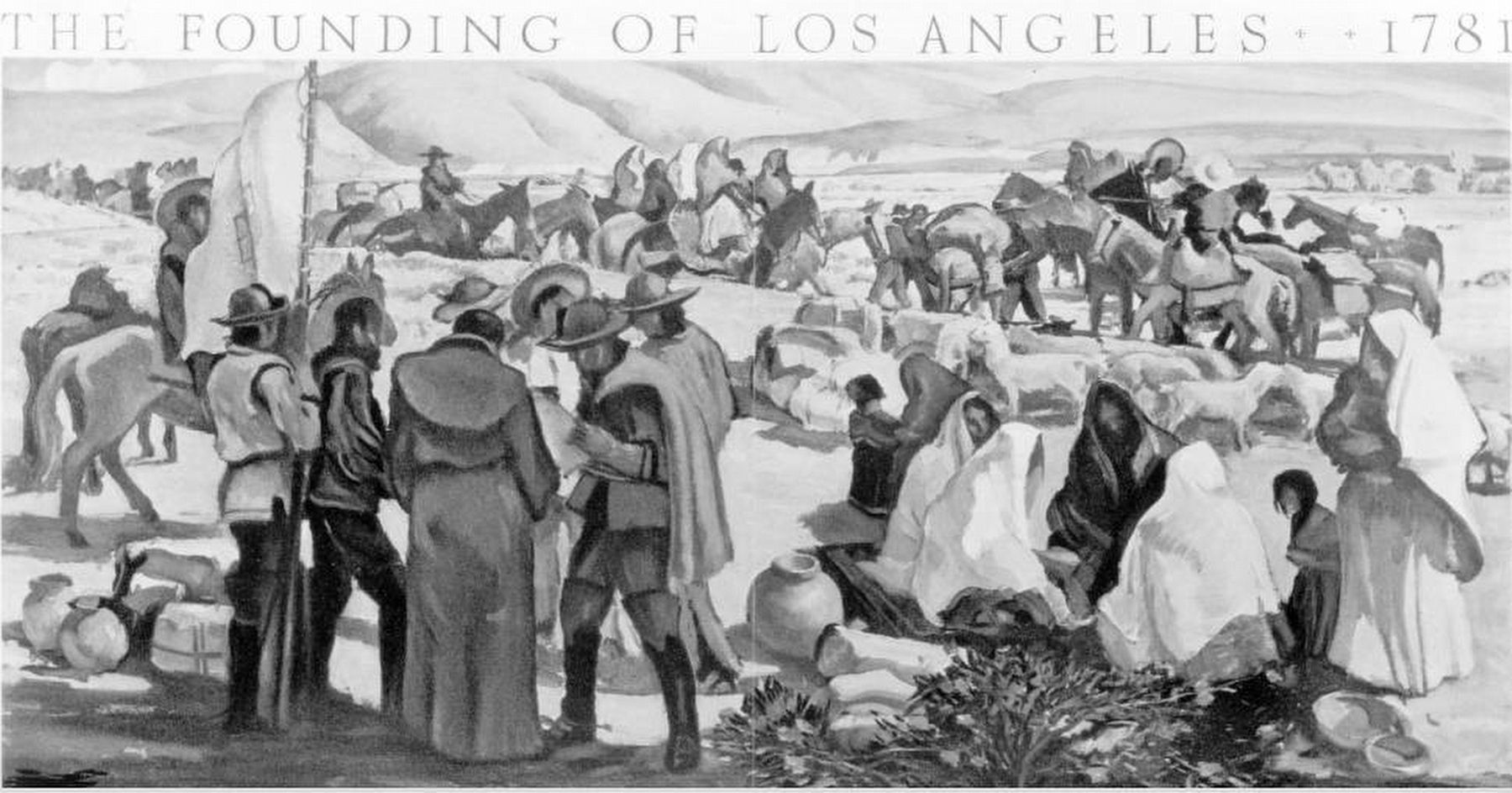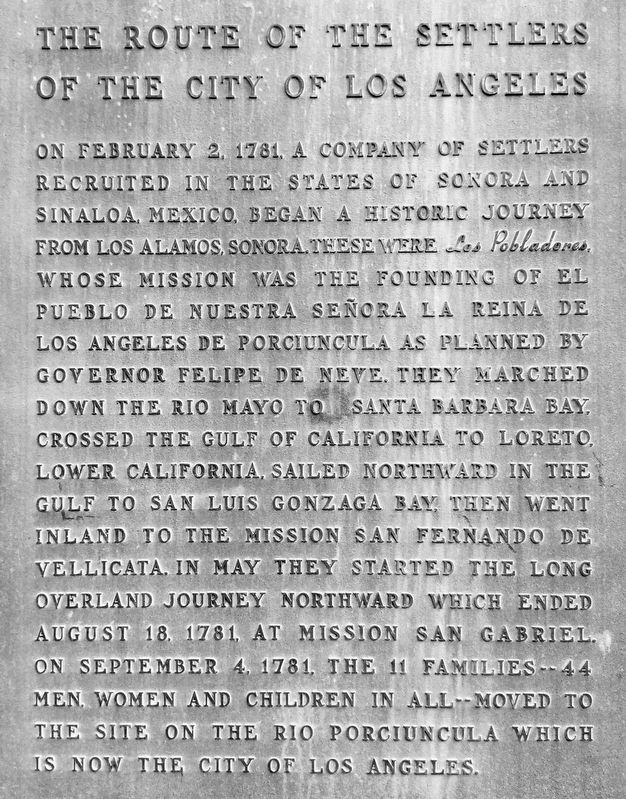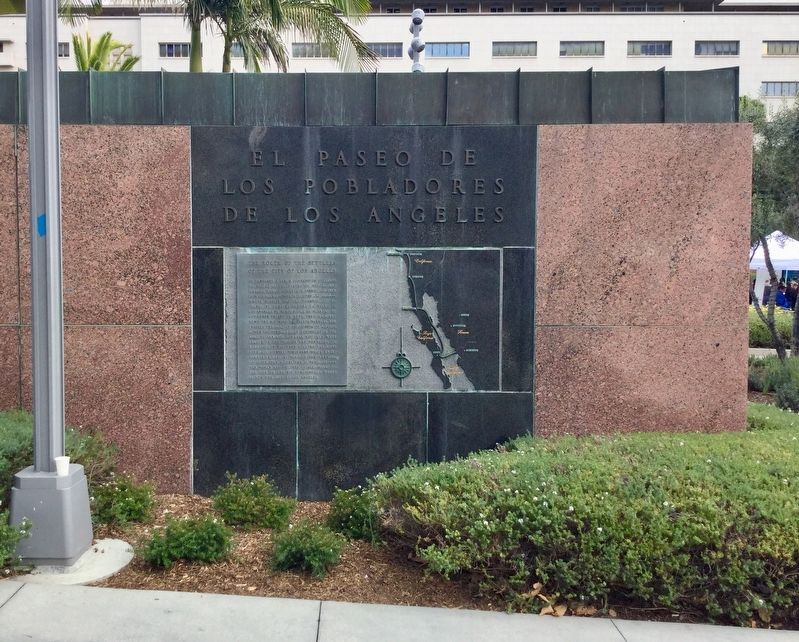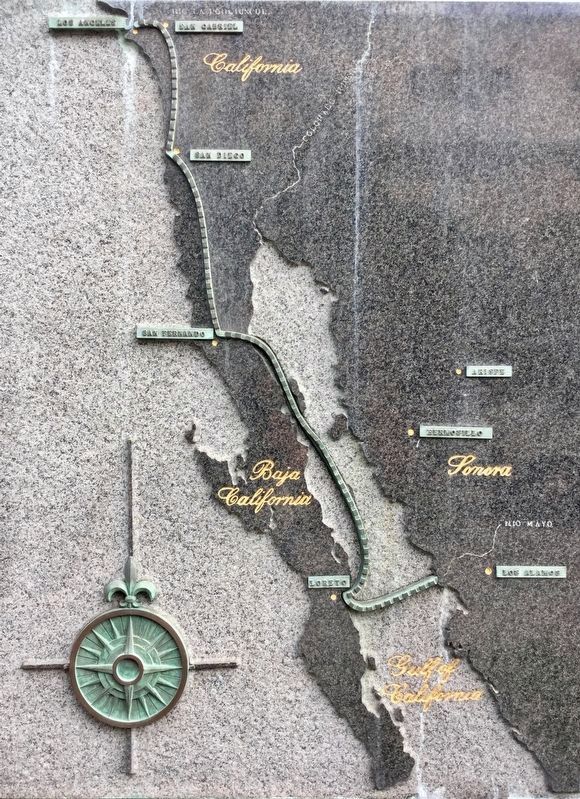Downtown Los Angeles in Los Angeles County, California — The American West (Pacific Coastal)
Route of the Settlers of Los Angeles
El Paseo de Los Pobladores de Los Angeles
On February 2, 1781, a company of settlers recruited in the states of Sonora and Sinaloa, Mexico, began a historic journey from Los Alamos, Sonora. These were Los Pobladores, whose mission was the founding of El Pueblo de Nuestra Señora la Reina de los Angeles de Porciuncula as planned by governor Felipe de Neve. They marched down the Rio Mayo to Santa Barbara Bay, crossed the Gulf of California to Loreto, Lower California, sailed northward in the gulf to San Luis Gonzaga Bay, then went inland to the Mission San Fernando de Vellicata. In May they started the long overland journey northward which ended August 18, 1781, at Mission San Gabriel. On September 4, 1781, the 11 families — 44 men, women, and children in all — moved to the site on the Rio Porciuncula which is now the city of Los Angeles.
Erected 1965 by County of Los Angeles.
Topics. This historical marker is listed in these topic lists: Hispanic Americans • Settlements & Settlers.
Location. 34° 3.366′ N, 118° 14.818′ W. Marker is in Los Angeles, California, in Los Angeles County. It is in Downtown Los Angeles. Marker can be reached from Grand Avenue north of First Street. Located in Grand Park, near the fountain. Touch for map. Marker is at or near this postal address: 133 N Grand Ave, Los Angeles CA 90012, United States of America. Touch for directions.
Other nearby markers. At least 8 other markers are within walking distance of this marker. Christopher Columbus (within shouting distance of this marker); a different marker also named Route of the Settlers of Los Angeles (within shouting distance of this marker); Vietnam Memorial (about 800 feet away, measured in a direct line); Department of Water and Power (approx. 0.2 miles away); Los Angeles Times (approx. ¼ mile away); Los Angeles City Hall (approx. ¼ mile away); The Lindbergh Beacon (approx. ¼ mile away); Temple Street Grade Separation (approx. ¼ mile away). Touch for a list and map of all markers in Los Angeles.
More about this marker. Rio Porciuncula, cited on the marker’s inscription, is today’s Los Angeles River.
This marker faces south, and an identical marker 200 feet away faces north.
Also see . . .
1. The Settlement of Los Angeles. Los Angeles Almanac website entry (Submitted on June 22, 2018.)
2. Los Angeles Pobladores. Wikipedia entry:
When the Governor of Las Californias, Felipe de Neve, was assigned to establish secular settlements in what is now the state of California (after more than a decade of missionary work among the natives), he commissioned a complete set of maps and plans (the Reglamento para el gobierno de la Provincia de Californias and the Instrucción) to be drawn up for the design and colonization of the new pueblo. Finding the individuals to actually do the work of building and living in the city proved to be a more daunting task. Neve finally located the new and willing dwellers in Sonora and Sinaloa, Mexico. But gathering the pobladores was a little more difficult. The original party of the new townsfolk consisted of eleven families, that is 11 men, 11 women, and 22 children of various Spanish castas (castes).(Submitted on August 29, 2020.)
3. The First Map of Los Angeles May Be Older Than You Think. 2013 article by Nathan Masters for KCET’s “Lost LA” website. Excerpt:
To induce the original settlers of Los Angeles to leave their homes in Sonora and Sinaloa for an uncertain future in far-off Alta California, the Spanish authorities offered several enticements. Governor Felipe de Neve described these benefits in his 1779 Reglamento, an early planning document that prescribed the town's layout and administration in detail. Upon arrival, settlers would receive livestock and an annual salary. They would also be granted—provisionally at first—several parcels of land: one house lot, two irrigated farm lots, and two dry farm lots. After five years, if they remained pobladores in good standing, the parcels would become theirs permanently.(Submitted on August 29, 2020.)

From the California Historical Society Collection at the University of Southern California., circa 1931
4. Mural painting which depicts the founding of Los Angeles photographed by Charles C. Pierce
This black and white reproduction was published in Touring Topics magazine in 1931. The name of the artist and the location of the mural was not given.
Credits. This page was last revised on February 19, 2024. It was originally submitted on June 22, 2018. This page has been viewed 1,485 times since then and 154 times this year. Last updated on August 30, 2020, by Craig Baker of Sylmar, California. Photos: 1, 2, 3. submitted on June 22, 2018, by Craig Baker of Sylmar, California. 4. submitted on August 29, 2020, by J. J. Prats of Powell, Ohio. • J. Makali Bruton was the editor who published this page.


